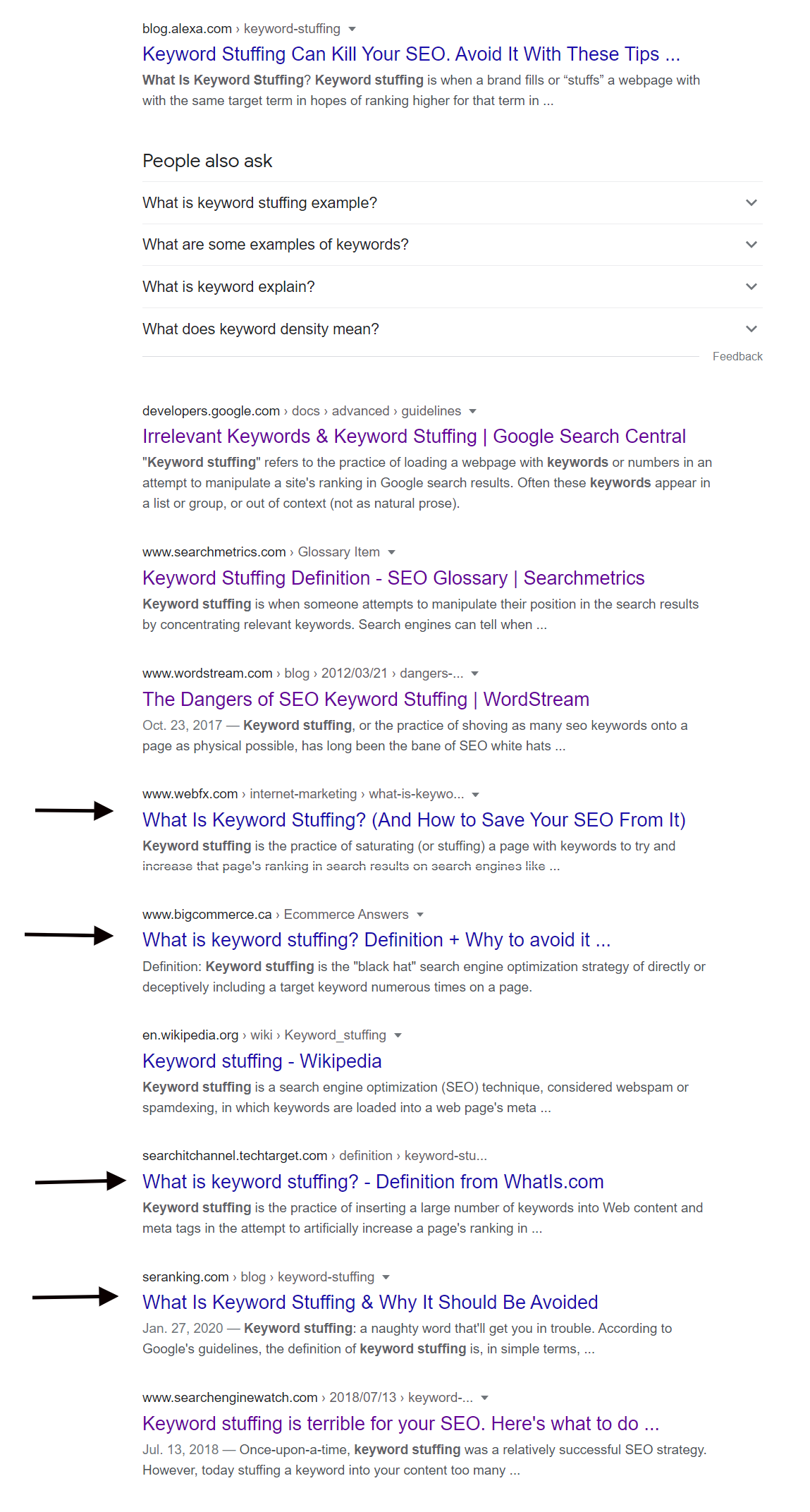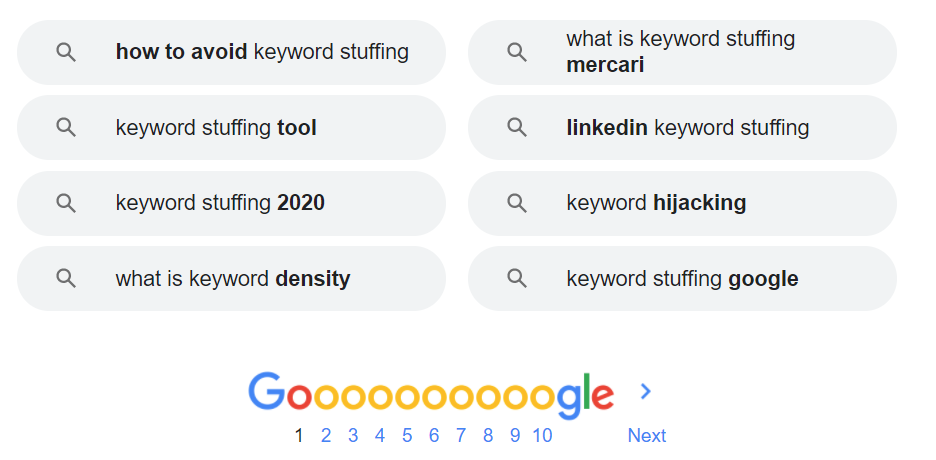There was once a time, early in the days of search engines, where keyword density calculators and keyword stuffing helped SEO. Those days have been gone a long, long time, but like a dog that once found an unexpected treat, people continue to go back to the idea of an ideal keyword density time and time again, no matter how hard SEOs, content creators, or even Google itself tries to dissuade them.
It’s not that keyword density calculators are wrong on the math; it’s that they encourage a view of how search engines work that is no longer accurate. With Google’s new focus on exciting advancements in natural language search, there are so many ways for people to optimize their content for Google—but keyword density is not one of them.
Keyword density and keyword density calculators can be harmful to content because they put content creators’ focus on metrics that don’t matter, often at the expense of actual ranking factors like readability and satisfying search intent.
How Do Keyword Density Calculators Work?
Keyword density calculators work by dividing the number of words in your content by the number of times you use your keyword and evaluating whether that number falls within an ideal range. This range can vary from about 0.5% to 2%, depending on the calculator you use.
For example, if you’ve just written a 1,000-word article with your keyword present 15 times, a keyword density calculator would divide 15/1000 and tell you that your keyword density is 1.5%. Depending on the calculator, it would then tell you whether your density is too high, too low, or just right. You could then adjust the number of keywords in your article to match the “ideal keyword density,” whatever this calculator believes to be the perfect number of times for a keyword to appear in your work.
The thinking behind these calculators is that Google looks for keywords in your articles to decide what your article is about. If you don’t have enough keyword occurrences, Google might think your article isn’t about this topic and pass it by when ranking. Too many keyword occurrences, and it can look like you’re trying to trick Google with keyword stuffing, the practice of inflating the number of times a keyword appears on your webpage to improve your rankings.
Early on in the internet, keyword density strategies like these paid dividends for SEOs, but nowadays, not so much.
How Can Keyword Density Hurt Content Quality?
Focusing on optimizing your content for an ideal keyword density can hurt your content quality because you are designing for something that no longer matters. Multiple experts, including Google itself, have said that keyword density is no longer a good SEO strategy.
We’ve also done some research here at SpyFu on the use of keyword density, and we found no evidence to suggest that keyword density improved rankings. However, a focus on keyword density can be more than just pointless—it can also damage your SEO in a number of ways.
It Can Make Your Content Sound Less Natural
Many writers use keyword density calculators to optimize their work after it’s written. However, this practice of adding or removing keywords often leads to awkward sentences that detract from the user experience that Google is looking for.
Google has been very upfront in the past that what they want is content that fulfills user intent. In their Search Quality Evaluator Guidelines, Google even states that, in their eyes, “high-quality content” is content that is “factually accurate, clearly written, and comprehensive.”
When you write to satisfy keyword density, you risk lowering your work quality by making it less clearly written. For example, long-tail keywords—keywords with more than two or three words that show a more specific user intent—can be notoriously difficult to actually write into content. However, this doesn’t stop some people from trying.
In this article, we can see what happens when a writer sacrifices readability for keyword density. Can you guess what keyword it is being optimized for?




When you look at these sentences, it can be painful to see how hard the writer has worked to shoehorn in awkward questions solely to fit their chosen keyword. But it really isn’t necessary. Not only is it not in line with what Google considers high-quality content, but it’s more than possible to rank without even having your keyword in your copy.
In our experiment, of the 42 posts we looked at, 12 of them didn’t have one mention of the keyword they were ranking for.
The clear takeaway: Natural writing should be prioritized over any notions of keyword density.
It Can Make Bad First Impressions
According to one study, readers spend 5.9 seconds reading your content before forming their first opinion on your website. If you’re focused on getting your keywords into the first sentence (which many people advocate) instead of writing an engaging hook, then you might be turning away the readers you are looking to attract with better SEO.
Why is this a problem? Other than losing the chance to convert a reader, Google considers satisfying user intent in their rankings (called the Needs Met rating). One way we believe Google calculates this is through dwell time, the amount of time someone stays on a page after coming from a search engine. If you stay on the result for a long time, Google can conclude that you’ve found the answer you were looking for successfully.
When your pages make poor first impressions on readers in those first 5.9 seconds, you increase the likelihood of them bouncing back to the SERP and lowering your dwell time.
Look at these two examples: Which one encourages you to stay and read more?


The first is clearly focused on getting its keyword out in front of Google. The keyword “the best dog food” appears three times in four sentences. The second introduction has it only once in the third paragraph. Currently, the first example is sitting in 38th on the search engine results page (SERP), while the second is in the eighth spot.
These very different rankings are due to many factors, but we can’t ignore that one of these introductions has put their readers first by writing engaging and informative copy. Readers make quick decisions when deciding whether your article has high-quality content that will satisfy their search intent. If your introduction is full of keyword stuffing, then you can expect readers will look elsewhere for whatever they’re searching for, hurting your dwell time and your chances of ranking in the process.
It Can Lead to Keyword Stuffing
Ironically, a tool that was partially designed to avoid keyword stuffing may inadvertently cause you to use this blackhat SEO technique. Keyword density calculators may be encouraging this practice by getting people in the mindset of adding as many keywords as possible without being caught by Google.
This way of thinking can lead to potentially harmful practices that contravene Google’s rules and negatively impact the user experience. One area we see this in is image alt texts. Alt texts are essential for two main reasons:
- They help visually impaired people understand the context or information that is being relayed by an image
- They help Google understand what images are on the page so they can rank them in Google Images
As Google states in its Google image best practices:
“When choosing alt text, focus on creating useful, information-rich content that uses keywords appropriately and is in context of the content of the page. Avoid filling alt attributes with keywords (keyword stuffing), as it results in a negative user experience and may cause your site to be seen as spam.”
However, many content creators and SEOs still believe that alt texts are best used as signals to Google that their page is about a certain keyword, as they may mistakenly think that keywords in alt texts won’t be caught out as keyword stuffing. For instance, in this blog post titled “10 amazing places in Southeast Asia that aren’t on the backpacker trail,” every one of their eleven pictures has the alt text “best places to visit in southeast asia.”

This is far from an isolated example. Only by moving past the myth of keyword density can we get rid of these practices that encourage keyword stuffing, especially when it comes at the expense of accessibility on the internet.
How Can I Optimize My Content Instead?
Instead of trying to meet an imaginary keyword goal, there are plenty of other things you can try to do with your keywords to improve your SEO. We can’t look at all of them here, but we want to look at three techniques you can use to improve your content and rankings, including focusing on search intent, keyword placement, and semantic SEO.
Identify the Search Intent Behind Your Keyword
As we stated earlier, Google wants content that matches up with readers’ search intent. When you can position your work as more valuable to your readers than the competition’s, you’re going to get rewarded by both readers and Google.
We’ve written a whole article on how you can perform a search intent analysis to create the best possible content for your readers.
In its most basic form, analyzing search intent boils down to:
- Understanding the search type: Are searchers interested in information (informational), buying something (transactional), moving to a specific website (navigational), or researching a product before purchasing (commercial investigation)? When creating your content, design with your keyword’s specific search type in mind.
- Researching the SERP: Look at the autofill suggestions, the highlighted terms, and the People Also Ask sections to see what Google sees as important. You can include this in your content to send positive signals to Google (more on this later).
- Checking out the competition: See what current top content is doing to satisfy search intent and get ideas on how you can improve on it.
When you understand the search intent behind a keyword, you can make killer content that provides real value to readers. With content that’s head-and-shoulders above the rest out there, there’s nothing between you and the top of the SERP.
Consider Keyword Placement
Although keyword density doesn’t help your SEO, keyword placement seems to still hold some relevance for your rankings. It can be challenging to tease out precisely what does and does not make an impact, but it appears that including your keyword in your title and your H2 is correlated with articles that rank well.
In the test we ran on keyword density assumptions, we found:
- 55% of articles that ranked had their keyword directly in at least one H2
- Only 28% had their keyword in more than one H2
- 95% of articles had either the exact match keyword or some variation of it
- 64% had the exact keyword in the title
None of these statistics are complete knockouts, but it does encourage you to continue putting your keywords into your title and at least one H2.
However, it’s important to remember that user experience should come before forcing these keywords into these spots. For example, with H2s, it’s important to focus on writing them in a way that helps readers quickly skim your work to find what they’re looking for.
Think of each H2 as a chapter title that describes what you can find there and consider a table of contents for any posts that exceed 3,000 words.
In titles, you may want to include your keyword, but it’s not worth making your title awkward in an attempt to force a long-tail keyword into it.
In the SERP for “what is keyword stuffing,” only four of the top nine (one link on the top 10 is Google itself) use the exact keyword, but all others have some variation on this idea.

There is some evidence to suggest keywords in H2s and titles can help you rank, but it’s always more important to prioritize your users before you consider these placements. As well, for many keywords, especially short-tail ones, you can expect to use them in your title and H2s naturally, without having to consciously add them afterward.
Use Semantic SEO
Semantic SEO focuses on ranking not through just answering a question well but by answering all of the follow-up questions a reader may have as well.
Instead of focusing your time on your primary keyword, it can help to find and include secondary keywords, synonyms, and related terms that send Google positive signals that your content is addressing all of the things it should be.
The easiest place to find these related terms and secondary keywords is the SERP.
You can look at:
- Highlighted words
- The People Also Ask section
- The Related Terms section
- The auto-fill feature in the search bar



One reason that semantic SEO is becoming more important is that Google is improving how it understands webpages. These changes relate to Google’s BERT update, where Google made its search engine better at understanding natural language and synonyms. So Google’s AI can understand that “quiche ingredients,” “ingredients for quiches,” and “what should I use in my quiche” are all based on the same search intent, even if the searches look different.
With Google’s crawlers and AI improving every day, it can help to move away from the traditional view of SEO based on the single almighty keyword and instead see SEO as proving to Google that your page has all of the answers to satisfy search intent. Instead of focusing on keyword optimizations, put in the research, write informative and comprehensive articles, and you’ll be seen as an authority in your field by both your readers and Google’s SERP.
It’s Time to Move Past Keyword Density
Although once a useful SEO technique, keyword density is now a thing of the past—and it’s high time that everyone got on board with that. This change does not mean that keywords or SEO optimizations are dead, but how we think about them has to change from the simple “more=better” concept of before to a deeper understanding of how people search and how Google understands that data.
If you want to learn more about recent changes to Google’s search algorithms and how it affects your SEO strategies, we’ve created a guide on how you can make sure your website is ready for BERT and natural language searches. Search engines, and thus SEO, change every day. Are you prepared for the future of the internet?

